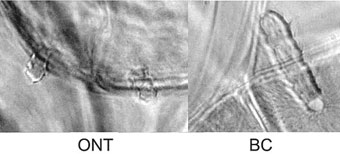Species 2k. Einfeldia pagana (Meigen, 1838)Syn: Einfeldia synchrona Oliver 1971 (Oliver et al. 1990) Adult of North American specimens described by Townes (1945) as Tendipes (Einfeldia) paganus, and by Oliver (1971) as E. synchrona. fore tarsus with a rather short beard. Light pea green, with thoracic markings, etc. ochraceous but occasionally brown or black; legs green, brown towards their apices. The inflated style abruptly constricted near the apex and the broad anal point are distinctive. Head: Frontal tubercles variable in size depending on locality, with those from British Columbia about 3 times the length of those from Ontario (Sublette, unpubl. data); with a seta approx. 4 times the length of the smaller tubercle. Clypeus with 18 - 30 setae.  Frontal tubercles of E. pagana from Ontario (left) and British Columbia (right). Thoracic setae: Acrostichals 5 - 11; Dorsocentrals 12 - 28, uni - to biserial; Prealars 5 - 6; Prescutella 1; Scutellar 7 - 13, uniserial laterally to multiserial medially. Scutellum with a small central hump. Legs with sparse beard, BR 3 - 5. Front LR 1.39 - 1.56; Mid LR 0.55 - 0.62; Hind L.R. 0.61 - 0.67. First tarsal segment of mid and hind legs with row of apically curved setae on anterior margin. Antennal flagellum 5-segmented, segment lengths (µm) 140-169 : 101-112 : 112-120 : 101-112 : 198-234. Head: Clypeus with 6 - 24 setae. Palp segments 2-5 (µm) 50-60 : 150-210 : 150-180 : 220-300. Thoracic setae: Acrostichals 7 - 8; Dorsocentrals 16 - 21; Prealars 5 - 6; Scutellar 12 - 14. Wing length 2.6 - 3.0; VR 1.10 - 1.18. Legs Front LR 1.66 - 1.79; Mid LR 0.50 - 0.54; Hind L.R. 0.57 - 0.62. Genitilia: Cercus quadrate. Larva not a Chironomus type but small (11.8 - 12.7 mm; 2 males) with only one pair of short ventral tubules (abt 0.56 - 0.66mm) and no postero-lateral tubules. Anal tubules about 300 µm long and 2.5-3 times longer than wide (ventral pair may be thicker). Cytology: 4 polytene chromosomes with no obvious indication of Keyl pattern. Found: British Columbia - (Sublette, unpubl.). Also found in the Palearctic (Belgium - region of Liége; Type locality). and claimed to occur in Asia, at least in Japan. DNA analyses: The difference in adult cephalic tubercles reported by Sublette (see above) could indicate the presence of different species under this name in the east and west of North America. The specimens of Curry (quoted in Oliver 1971) with scale like teeth is Einfeldia species A of Epler (2001) (see species 5b). The adult and pupa of this species are presumably similar to E. pagana, as Epler notes that J. E. Sublette identified an an adult and pupa of species A as E. pagana. |
Modified: 5 July 2025
Access: Unrestricted
Copyright © 2001-2025, Jon Martin.